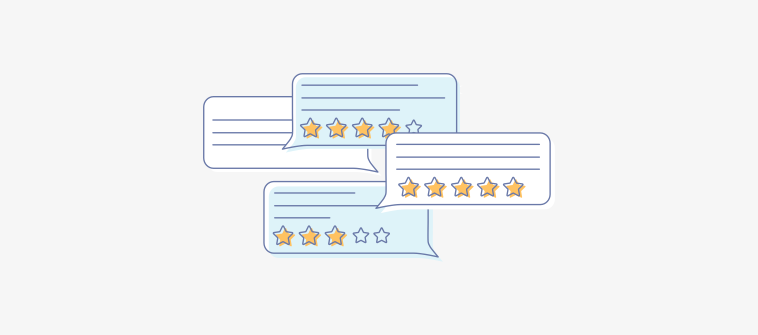Just like most teams, my team was spending nearly 28% of their workweek—about 11 hours—just reading and responding to emails. That was a lot of time lost in email back-and-forth, cluttered inboxes, and missed messages.
For this, I asked founders, managers, and senior leaders what could be the solution, and they all had one answer in mind — “shared inbox software makes all the difference.” Instead of juggling multiple email threads, teams can collaborate in real-time, assign tasks seamlessly, and track conversations without anything slipping through the cracks. It’s not just about efficiency—it’s about making teamwork effortless.
In this guide, I’ll walk you through the 10 best shared inbox software options for 2025, along with a quick breakdown of my top three picks. Plus I will also show you how to create your own shared inbox in simple steps.
What Is Shared Inbox Software?
Shared inbox software is a collaborative email management tool that allows multiple team members to access, manage, and respond to emails from a single, unified inbox.
Common team inboxes like support@company.com, sales@company.com, info@company.com, etc., receive hundreds of emails daily, making it challenging to track conversations and ensure timely responses. Instead of forwarding emails or copying teammates on threads, shared inboxes let teams view conversations in real time, assign messages, and add internal notes for seamless communication.
Quick Overview: Spotlight on the Top 3 Shared Inbox Tools
Before exploring the complete list of the best
shared mailbox software and tools, let’s look at my top three favorites and what they are good at.
Option 1 – ProProfs Help Desk
ProProfs Help Desk simplifies team email management by centralizing all customer communications into a single shared inbox. It offers a shared space for all your customer-facing inboxes (sales@, support@, help@, billing@, contact@, etc.). Its simple Gmail-like user interface makes resolving customer issues a breeze.
Option 2 – HubSpot Service Hub
HubSpot Service Hub enables a comprehensive shared inbox that integrates seamlessly with its CRM, allowing teams to manage customer interactions efficiently. It enables real-time collaboration, ticket assignment, and automated workflows to ensure timely responses.
Option 3 – Kayako
Kayako enables a powerful shared inbox platform that consolidates customer emails, social media messages, and live chats into a single interface. This tool supports real-time collaboration, allowing team members to work together on resolving customer issues.
List of Top 11 Shared Inbox Software
Over the years, I’ve tested multiple shared inbox tools to find the ones that truly simplify team collaboration and email management. Some excel at automation, while others shine in real-time collaboration.
Based on my experience, here are the top 10 shared inbox software that can help your team stay organized, respond faster, and eliminate inbox clutter.
1. ProProfs Help Desk – Best for AI-Assisted Shared Inbox for Customer Delight
I have been using ProProfs Help Desk for 2+ years and feel it’s the most user-friendly solution out there. With a robust shared inbox, it takes email management to a whole new level. Agents can easily collaborate to solve complex issues, leave internal notes, prioritize urgent issues, and track every email conversation—all from a common dashboard.
The product comes with dedicated cloud hosting on IBM servers, allowing you to manage shared emails while working from the office, at home, or on the road. Also, with a Gmail-like user interface, managing thousands of customer emails will feel familiar and far better.
My team loves its automation capabilities like AI-powered responses, automated alerts, ticket routing, etc. All these automation combined have helped us reduce human errors, improve response times, and enhance productivity.
What You Will Like:
- Create and use canned responses for common customer emails
- Agent collision detection helps you avoid sharing multiple replies to a single email
- ProProfs Live Chat, Knowledge Base & CSAT for a complete solution
- Smart reports to measure response and resolution times
What You May Not Like:
- The forever-free plan is limited to a single user only
- Dark user interface option is not available.
Pricing:
- FREE for a single user. Plans start at $19.99/user/month for 2 or more users.
2. HubSpot Service Hub – Best for HubSpot Ecosystem Users
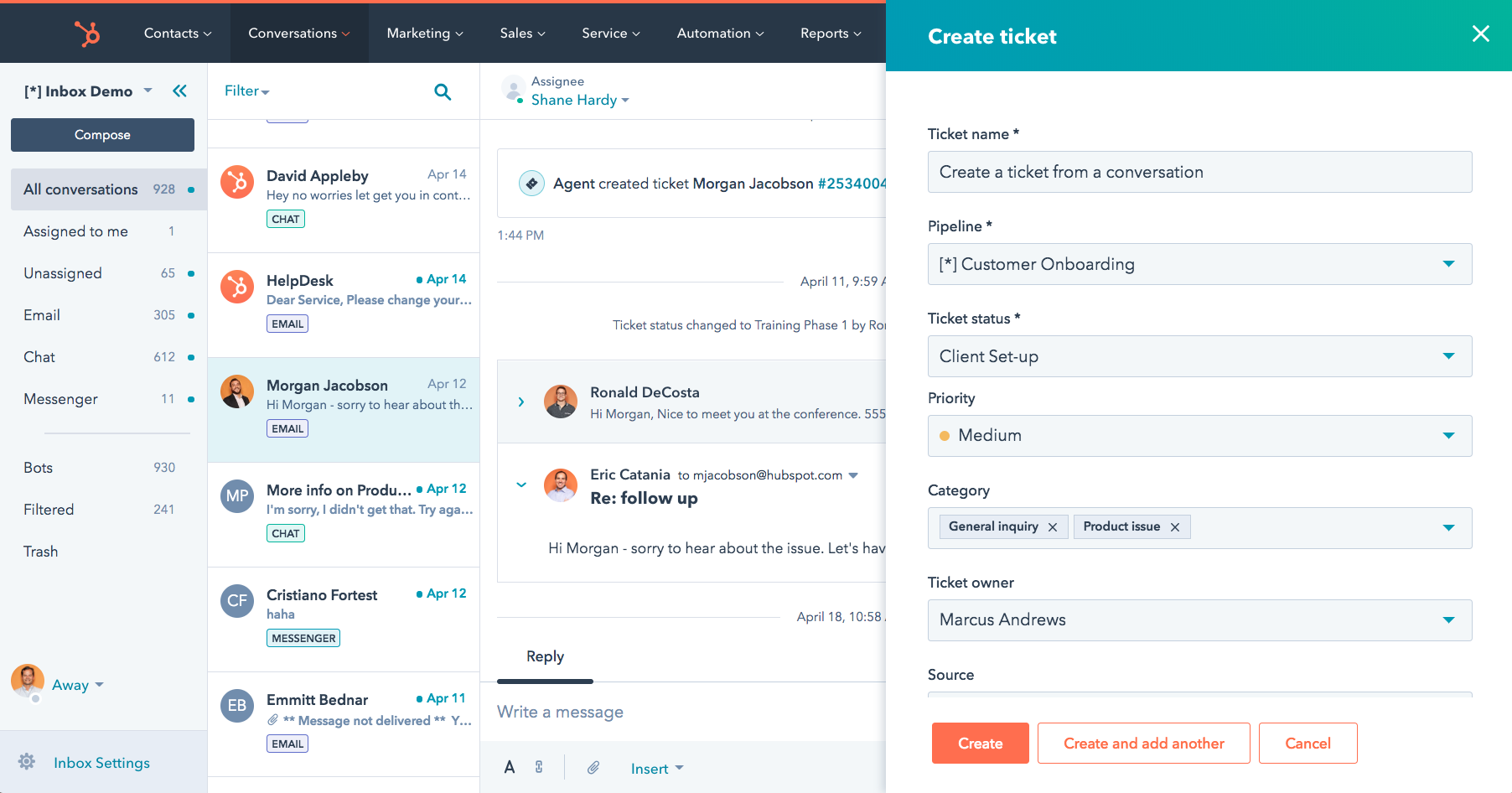
Image Source: HubSpot Service Hub
I like HubSpot’s universal inbox that connects multiple email addresses and gives different teams—marketing, sales, and customer service—a single place to view and manage all conversations. Users can have complete transparency and will never have to guess whether someone has followed up on an important email.
For HelpSpot ecosystem users, it integrates seamlessly with its CRM, enabling users to manage customer interactions efficiently. Users can easily set up routing rules to assign emails to specific individuals or distribute them evenly among all team members. Filters make it easier to sort through conversations and find the ones you seek.
What You Will Like: :
- Set up routing rules to automatically send emails to relevant agents or teams
- Leverage pre-designed templates and canned responses for faster replies
- Get all the context you need for personalized and meaningful conversations.
What You May Not Like: :
- I have noticed that the search engine cannot read the document attached in a pdf format
- The form submissions are a bit complicated to reply to in a ticket and almost always cause two tickets to appear per submission.
Pricing:
- Paid plan starts at $15/user/month.
3. Front – Best for Email Automation & Collaboration
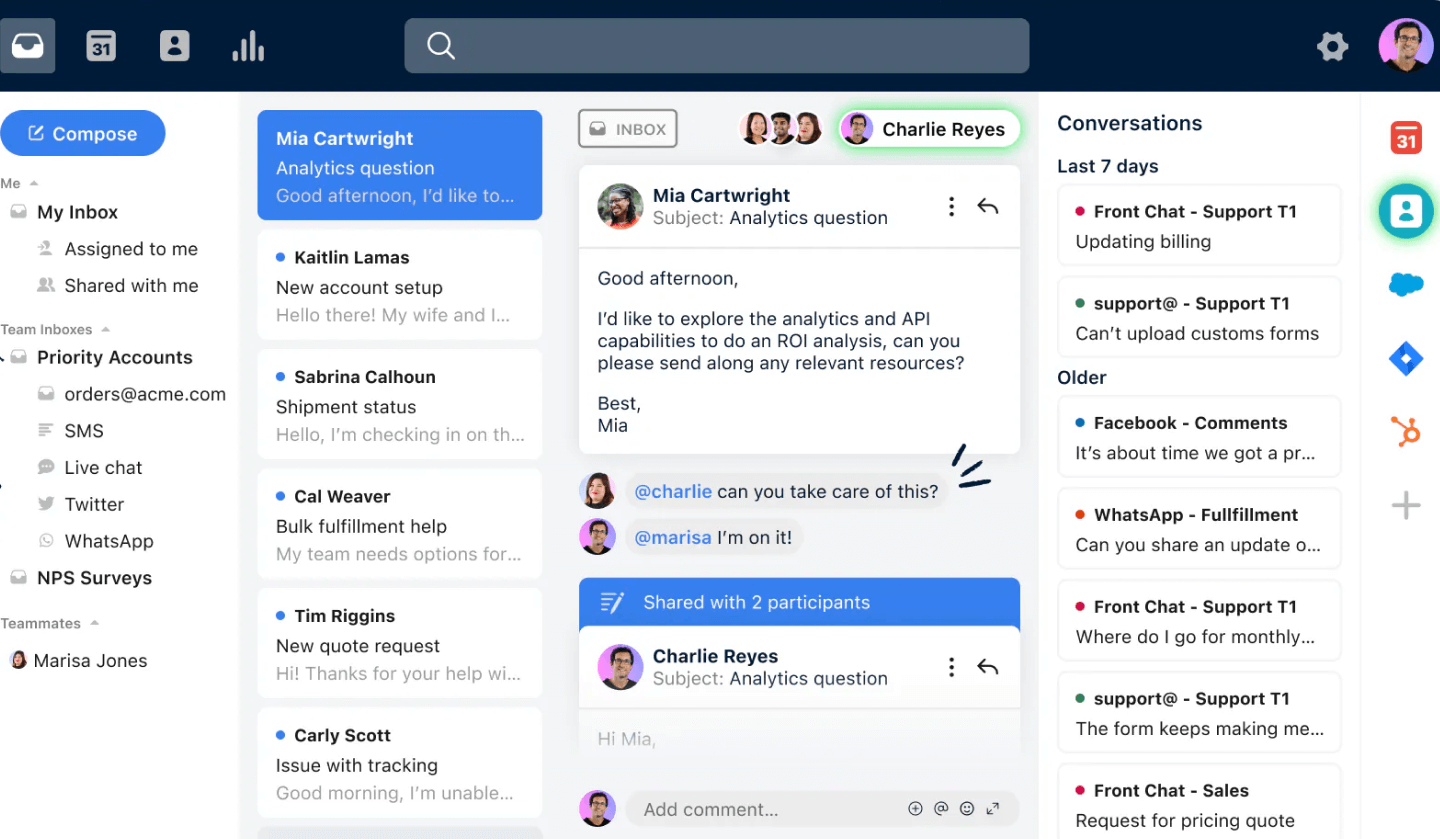
Image Source: Front
Front enables teams to automate routine tasks like sorting, tagging, and assigning emails, which significantly reduces the manual workload. I like how you can set automation rules based on email content, sender, or other criteria, ensuring that emails are immediately directed to the right person or team.
The platform allows team members to work together on emails in real-time, adding internal comments and sharing drafts before sending a response. Team members can also mention each other directly within the email threads, facilitating seamless communication and quick resolution of queries.
What You Will Like:
- Multiple integration options with CRM systems and project management tools
- Unified view of customer interactions
- Robust reporting and analytics tools to track response times, email volumes, and team workload distribution.
What You May Not Like:
- The pricing can get expensive as your team grows
- Some users report delays or inconsistencies when syncing emails
Pricing:
- Paid plan starts at $49/user/month.
4. Help Scout – Best for Customer Conversations & Unified Platform
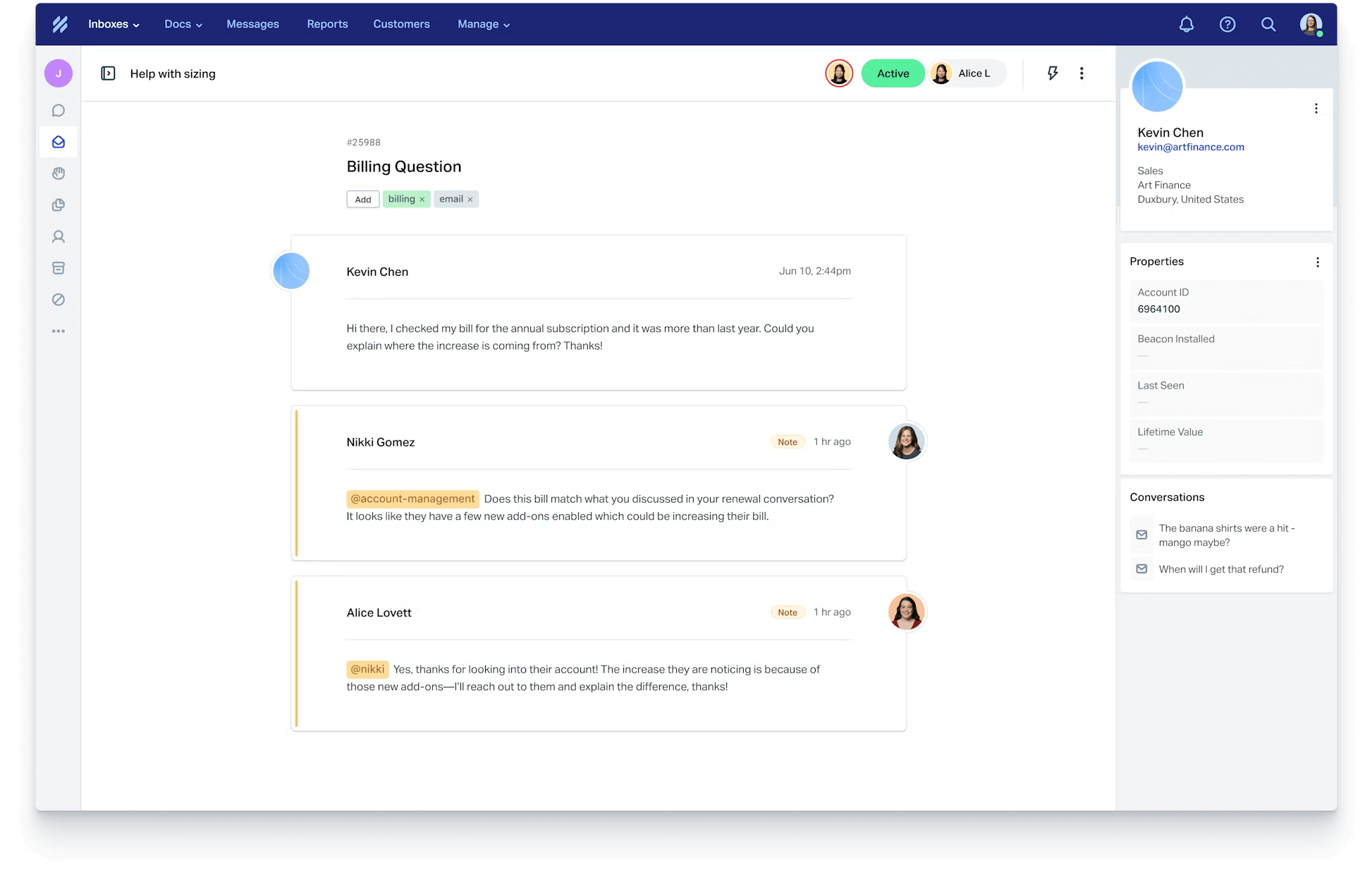
Image Source: Help Scout
Whether you have a team of 3 or 300, I love how Help Scout keeps all your customer service agents on the same page. Before replying to customers, your agents can send private notes with @mentions to other team members. This ensures you always share the most appropriate response to customers.
With Help Scout, you can even create a vast library of answers to frequently asked questions. Within just a few clicks, agents can easily insert these answers into their responses and offer instant help to customers.
What You Will Like: :
- Set up powerful automation and reduce repetitive tasks
- Find exactly what you need with advanced filters, bulk actions, and quick views
- Send private notes to team members before replying to a customer.
What You May Not Like: :
- Cannot download CSV file after filtering the emails with tags
- There should be a feature to separate onboarding/implementation vs. support tickets.
Pricing:
- Paid plan starts at $20/user/month.
5. Freshdesk – Best for Multichannel Communication
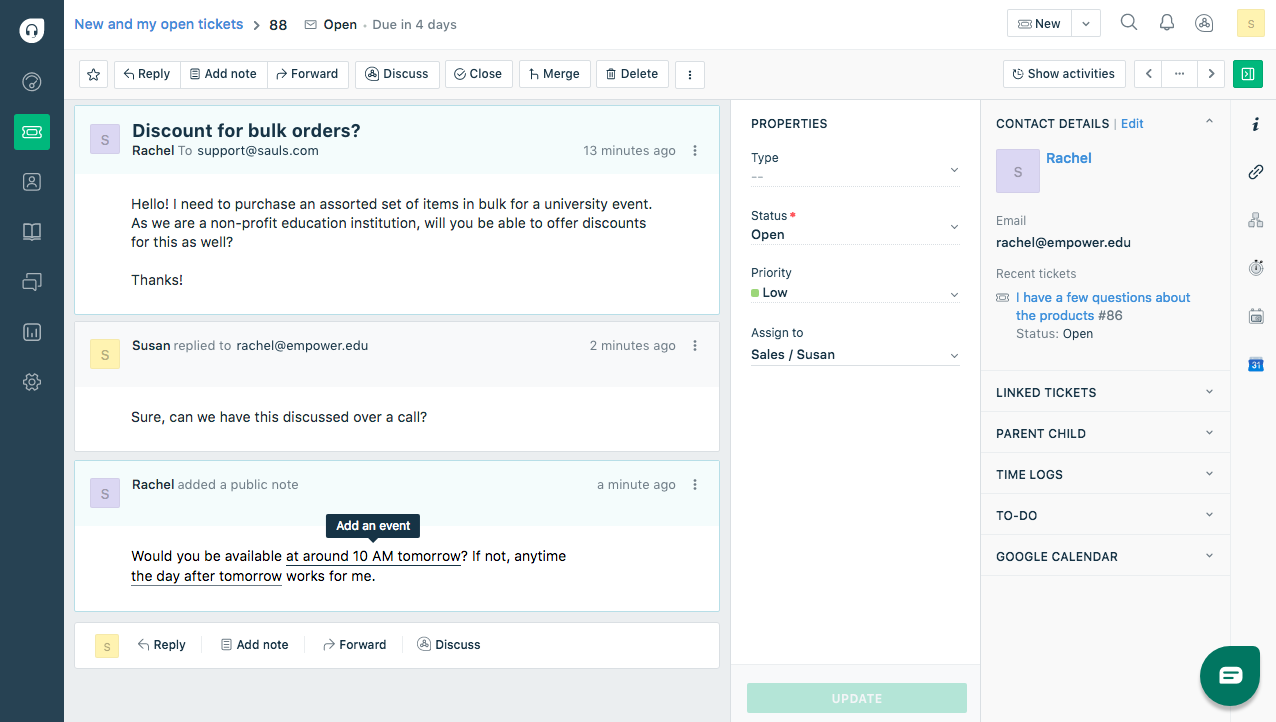
Image Source: Freshdesk
Freshdesk is another popular shared inbox software that I think does a commendable job of converting incoming requests to your support email into helpdesk tickets. These tickets can then be easily prioritized and assigned to the right customer service agents.
It enables multichannel communication by consolidating customer interactions from email, phone, chat, social media, and more into a single shared inbox. Users can integrate their favorite business applications, such as CRM, payment solutions, bug-tracking software, etc., with Freshdesk for a holistic support experience.
What You Will Like: :
- You can create multiple custom views to access support tickets quickly
- Prevent sharing multiple replies to the same customer using agent collision detection
- Create canned responses to respond to common customer emails quickly.
What You May Not Like: :
- For some users, navigating through the dashboard can be challenging, with essential features buried under confusing menus
- Some basic features like “Set Ticket Field Options” and “Hide Fields” should be built-in into the system instead of users relying on third-party apps.
Pricing:
- Paid plan starts at $15/user/month.
6. HappyFox – Best for Insightful Reports & Analytics
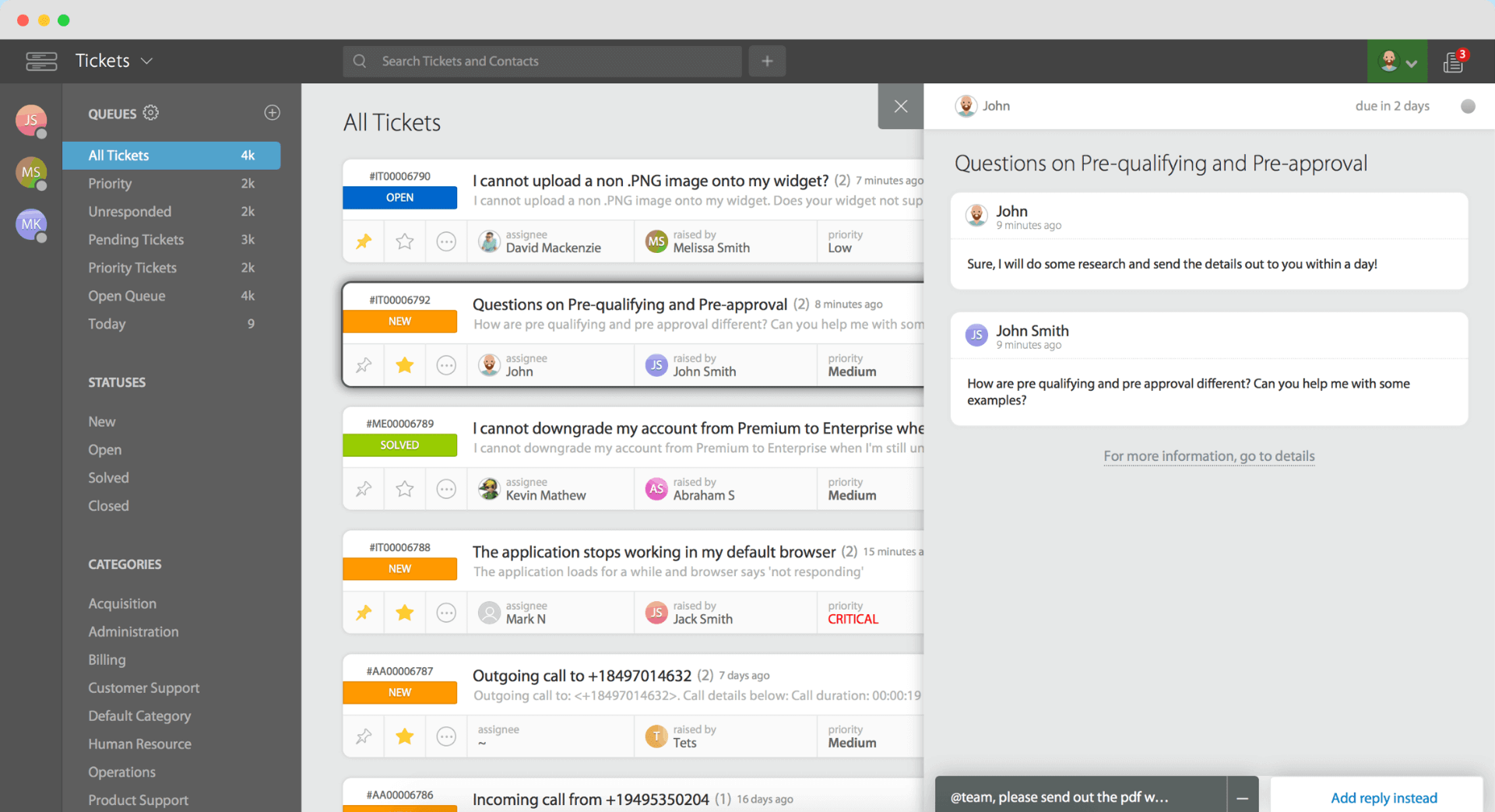
Image Source: HappyFox
HappyFox is a world-class team email management tool that comes with 35+ languages to help you offer multilingual support. I found its dashboard very user-friendly, where you can queue up your email conversations and threads to resolve them orderly.
It enables detailed metrics on ticket volumes, response times, and agent performance to help teams track key performance indicators, identify trends, and make data-driven decisions. It also lets agents use private notes to discuss tickets internally before drafting a response and hitting the send button.
What You Will Like: :
- Enables managers to add tasks and due dates to maximize productivity and streamline support operations
- Seamlessly integration with Facebook and Twitter
- Automatically convert social media messages into unique tickets.
What You May Not Like: :
- The inputs are not as customizable as a regular user would like and, at times, make it difficult to ensure a ticket is getting to the right person
- I felt the need for additional training resources available for new users to get up to speed more quickly.
Pricing:
- Paid plan starts at $26/user/month.
7. Hiver – Best for Email-Based Help Desk Solution
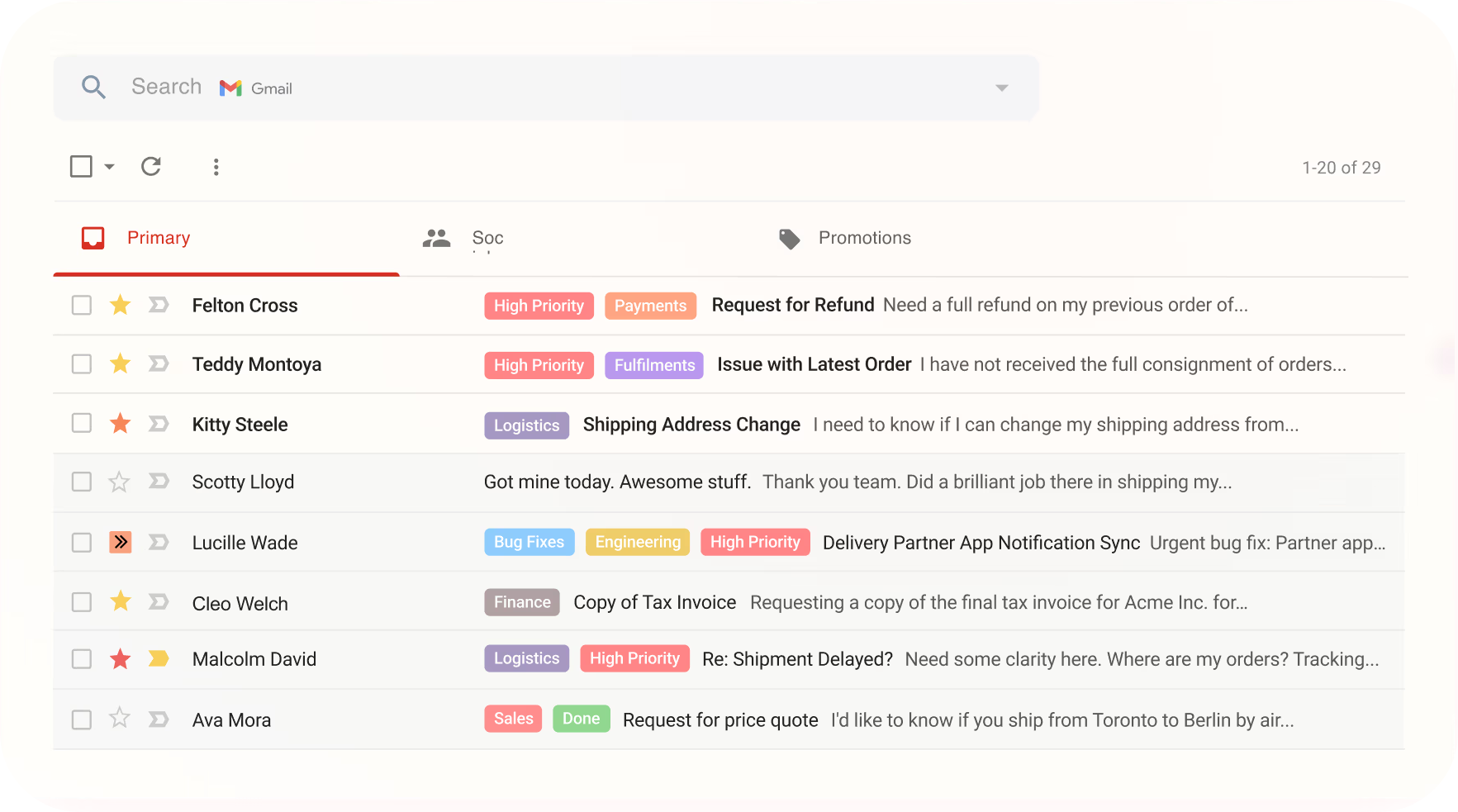
Image Source: Hiver
Hiver is another emerging shared inbox tool built on top of Gmail. According to me, the best is that this tool presents Notes alongside emails so that agents can always get the right context. Also, internal notes are private and not visible to customers.
With Hiver, agents can assign, track, and respond to customer emails from the Gmail interface without additional software or a dashboard. Therefore, you do no need to train your agents to learn any new software.
What You Will Like: :
- Make the most of your Gmail interface without switching software
- Collaborate in real-time with team members while drafting responses
- Set multiple SLAs and get notified in case of SLA violations.
What You May Not Like: :
- It would be nice to have the ability to sort emails from oldest to newest
- Analytics can be a little hard to follow at times.
Pricing:
- Paid plan starts at $12/user/month.
8. Kayako – Best for Centralized Support Conversations
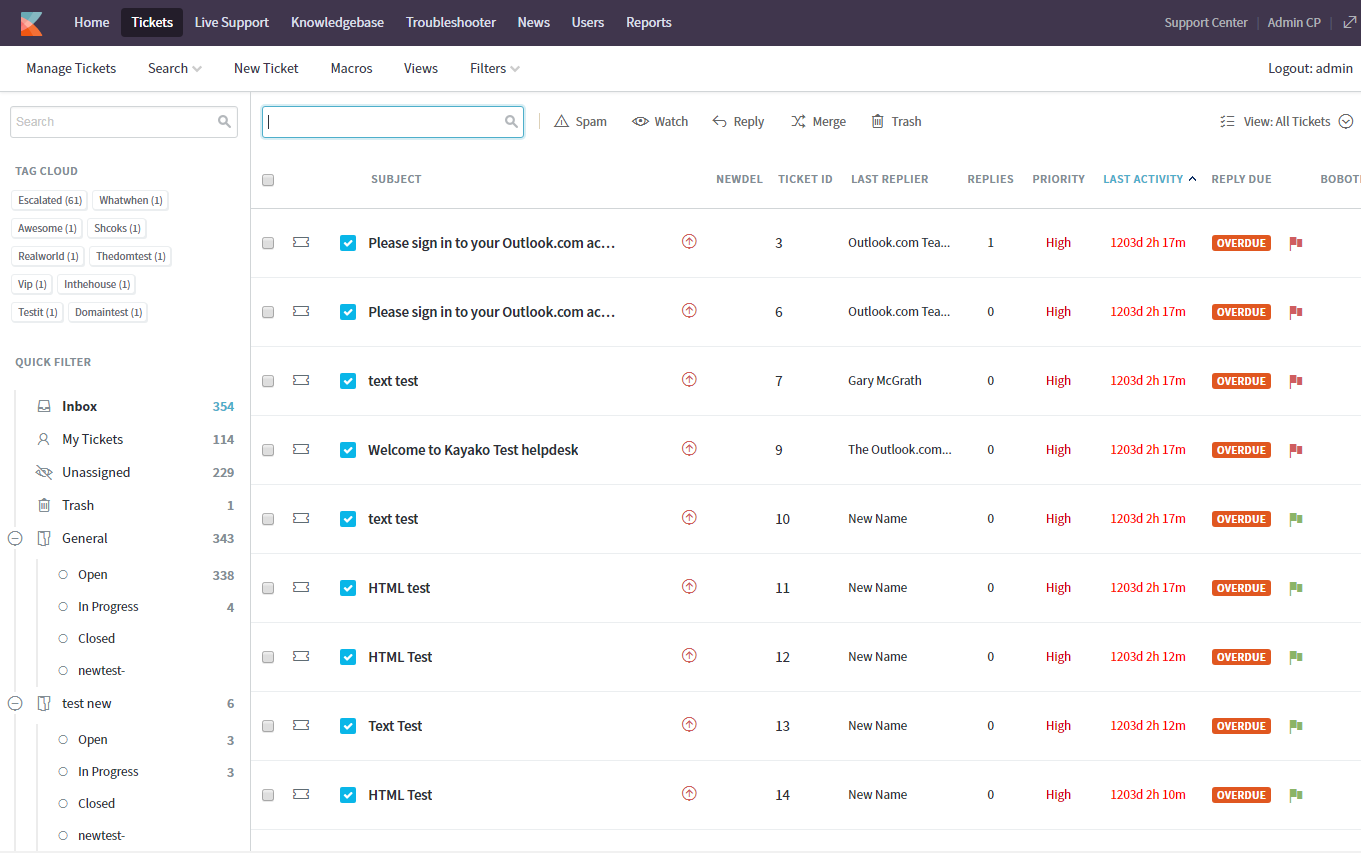
Image Source: Kayako
Kayako is a popular shared inbox for teams of all sizes. The ‘Tags’ feature helps easily categorize emails and organize all external as well as internal conversations in a single place.
Its ‘SingleView’ offers a complete visualization of the entire customer journey that includes stages such as – purchase history, recent activities, and interactions with other agents. This gives relevant context to your agents so that you don’t have to ask additional or repetitive questions.
What You Will Like: :
- One of the most beautiful user interfaces
- The ability to see tickets assigned to users as well as see what’s in your queue
- Good localization to add your own translations to (just) the on-premise version.
What You May Not Like: :
- I felt it was not suitable for small teams – requires a lot of time and effort to set up
- Absence of an auto-refresh option for loading newer tickets.
Pricing:
- Kayako offers custom pricing.
9. SupportBee – Best for Robust Ticket Categorization
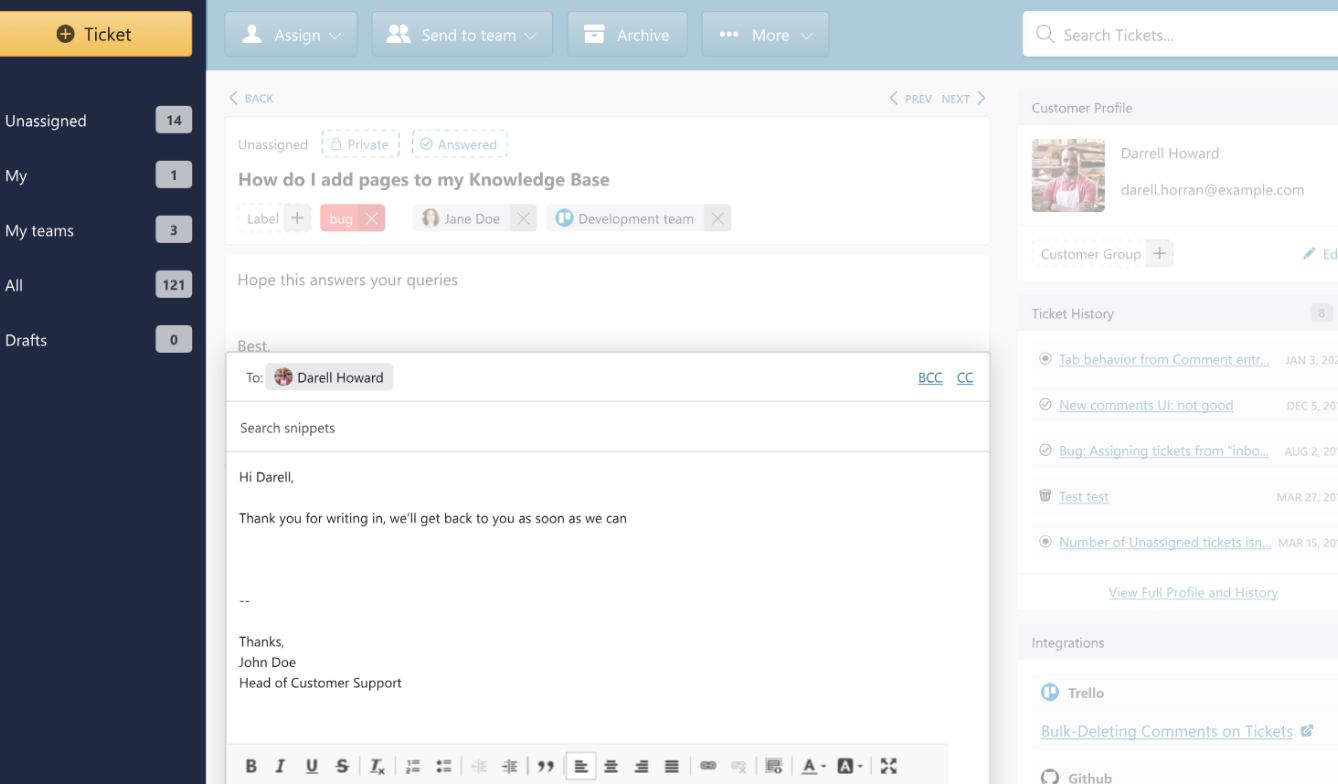
Image Source: SupportBee
I love how SupportBee offers the familiarity of an email interface while enabling many powerful email collaboration features. You can categorize tickets as Answered, Unanswered, or Archived. This helps you keep your inbox organized and clearly communicates which tickets in your shared inbox need your immediate attention.
Moreover, users can assign tickets to the most relevant agents or teams, add internal comments on tickets to discuss them and share draft responses for review before sending them off to the customer.
What You Will Like: :
- Save draft responses and tag team members to get them reviewed
- Add private comments for team collaboration on tickets
- Support multiple brands using email signatures.
What You May Not Like: :
- Lack of a robust live chat widget
- There should be an API to launch bots for customer support.
Pricing:
- Paid plan starts at $13/user/month.
10. Salesmate – Best for Shared Inbox + CRM Integration
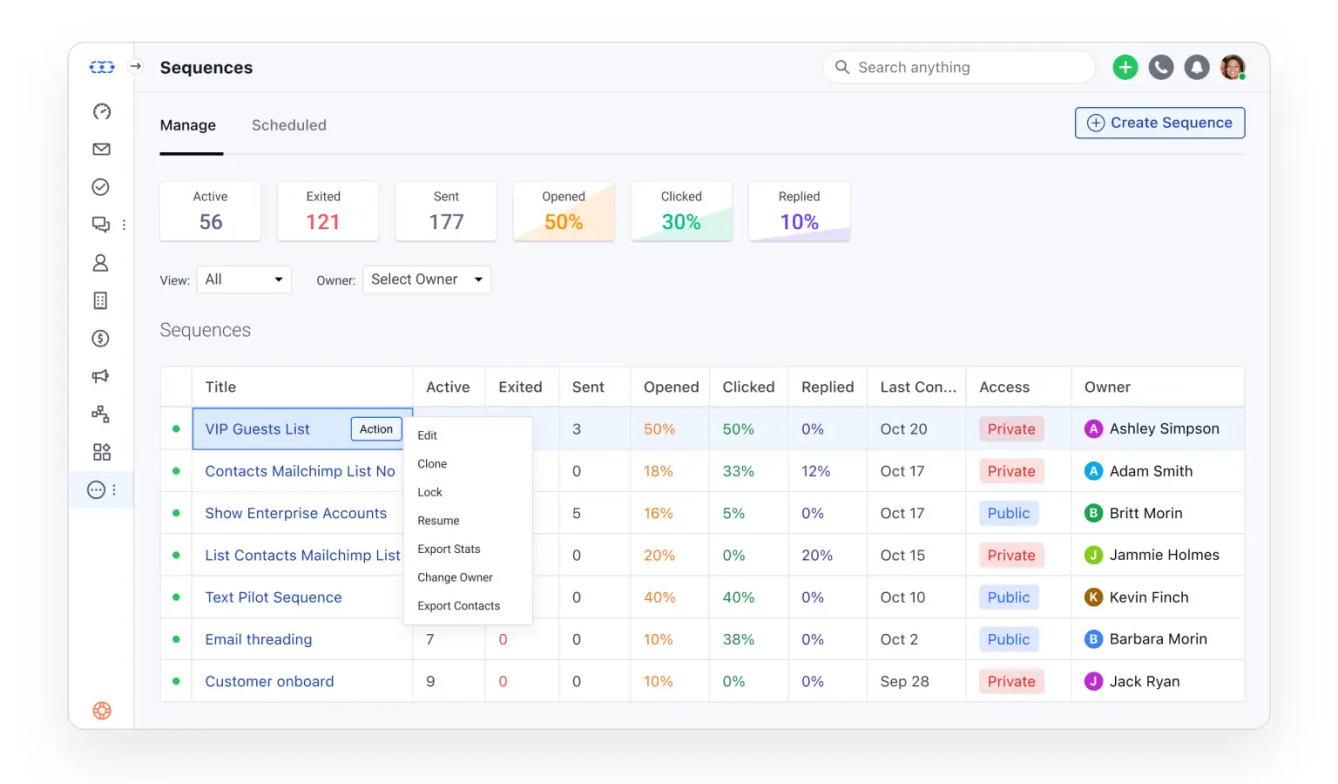
Image Source: Salesmate
Salesmate is a shared email management tool designed to streamline communication and collaboration for sales and support teams. With a unified inbox, teams can manage customer conversations efficiently, ensuring no message goes unanswered.
The platform offers smart automation, allowing teams to assign emails, set up workflows, and track communication in real time. Salesmate also integrates with CRMs and productivity tools, making it a seamless choice for businesses looking to improve response times and build better customer relationships.
What You Will Like:
- Automated email assignment to distribute emails to team members
- Tag conversations with various colors to filter and identify them quickly
- CRM Integration connects with Salesmate CRM to track customer interactions.
What You May Not Like:
- The platform lacks in-depth analytics and reporting features
- Not Ideal for large enterprises as it is best suited for small to mid-sized teams.
Pricing:
- Starts at $23/user/month.
11. Canary for Support – Best for AI-Powered Shared Inbox Collaboration
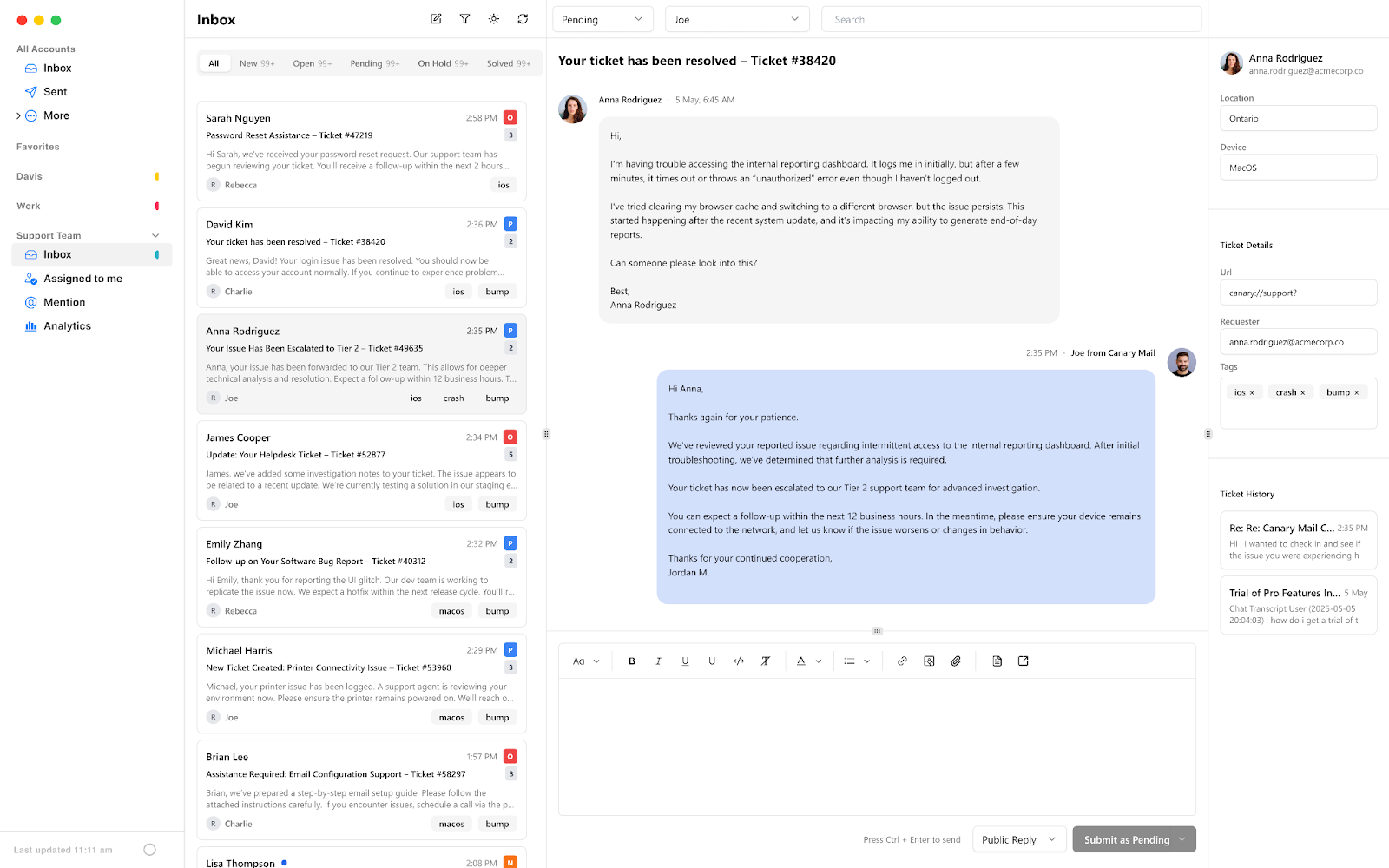
Canary for Support offers a powerful shared inbox solution built for modern teams. Designed with simplicity and speed in mind, it lets support teams manage group emails collaboratively without stepping on each other’s toes. Canary sets itself apart with built-in AI capabilities that boost productivity while keeping the interface clean and easy to use.
With Canary’s shared inbox, every team member can see incoming tickets in real-time, assign them to the right person, and track progress with ticket statuses. You can also mention teammates and leave internal comments on tickets.
What You’ll Like:
- Minimal, focused UI that’s easy to onboard and adopt
- One modern app for support, team, and personal email
- Works seamlessly across desktop and mobile
What You Won’t Like:
- No live chat, phone support, or multichannel inbox—strictly email-based
- Fewer third-party integrations compared to traditional helpdesk tools
Pricing:
- Starts at $10/user/month.
Why Do You Need Shared Inbox Software?
Well, now that you know what shared inbox software is, let me show you some compelling reasons why you need one.
1. Centralized Communications
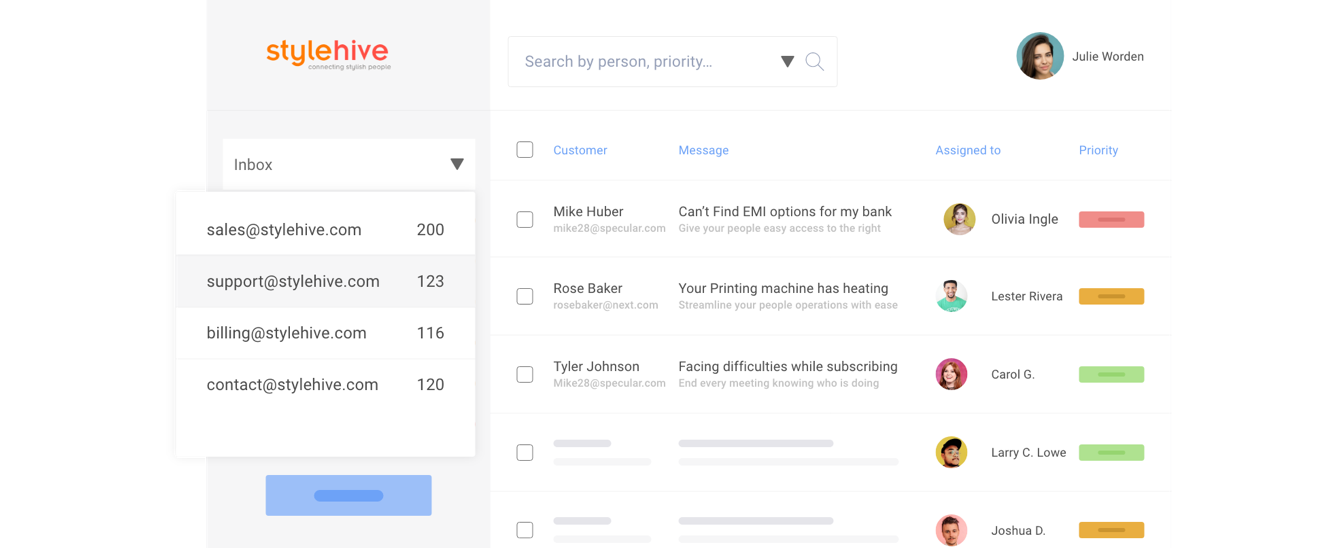
A shared inbox brings all your team’s emails into one place, eliminating the hassle of managing multiple email accounts. Whether it’s sales, support, or general inquiries, your team can access and respond to messages from a unified dashboard. This prevents missed emails, ensures accountability, and streamlines communication across departments.
2. Prioritize Urgent Emails
With a shared inbox, you can categorize and prioritize emails based on urgency, ensuring that critical messages don’t get buried under routine inquiries. Automated tagging, SLA rules, and escalation features help teams focus on pressing matters first, improving response efficiency and customer satisfaction.
3. Encourage Real-Time Collaboration
Collaboration is seamless when multiple team members can view, comment on, and assign emails within a shared inbox. Instead of forwarding emails or switching to messaging apps, teams can leave internal notes, discuss responses, and ensure the right person handles each conversation. This reduces confusion and enhances teamwork.
4. Respond Faster with AI
AI-powered shared inboxes offer features like automated response suggestions, email templates, and intent recognition to speed up replies. By leveraging AI, teams can craft accurate, professional responses in seconds, reducing workload and maintaining consistency in communication while ensuring customers get timely resolutions.
5. Measure & Improve Response Times
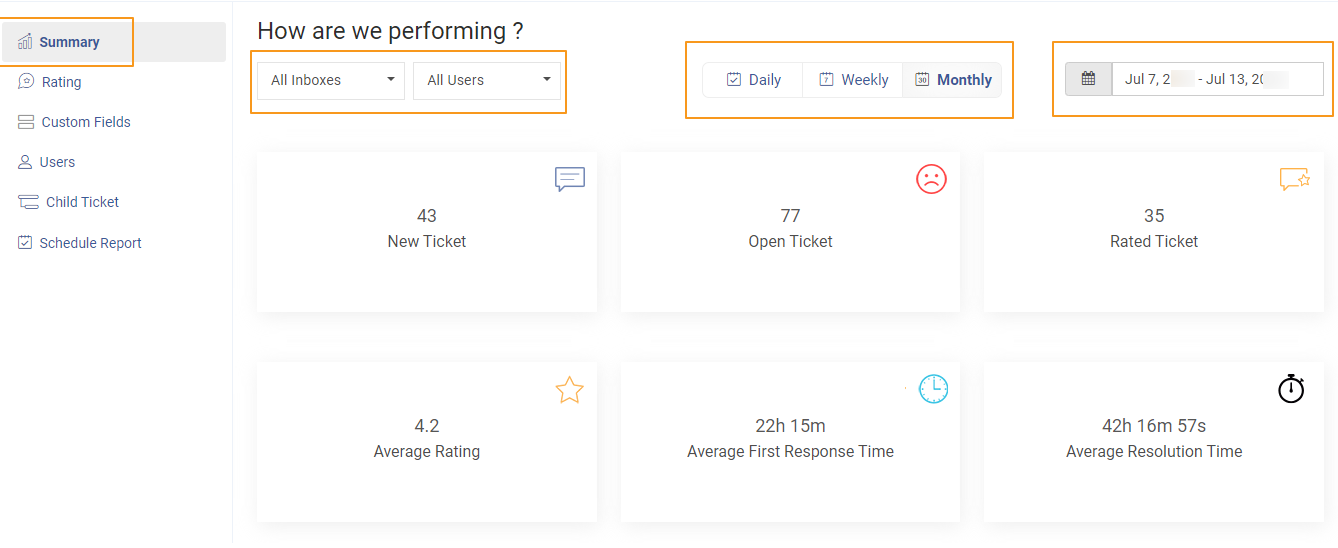
A shared inbox provides analytics to track key performance metrics, such as response time, resolution rates, and email volume. With real-time insights, managers can identify bottlenecks, optimize workflows, and ensure that SLAs are met. By continuously improving response times, teams can enhance productivity and provide exceptional support.
FREE. All Features. FOREVER!
Try our Forever FREE account with all premium features!
How to Create a Shared Inbox in Simple Steps
Creating a shared inbox is quite simple, given you have the right tool at your disposal. You can watch this short video for the same or follow the steps mentioned below.
I’ve taken the example of ProProfs Help Desk here, as it’s easy to set up and helps my team centralize customer requests, feedback, and queries in one place.
Step 1: In your ProProfs Help Desk account, navigate to Settings. The Inboxes page under Channels will open by default. Click “+New Inbox.”
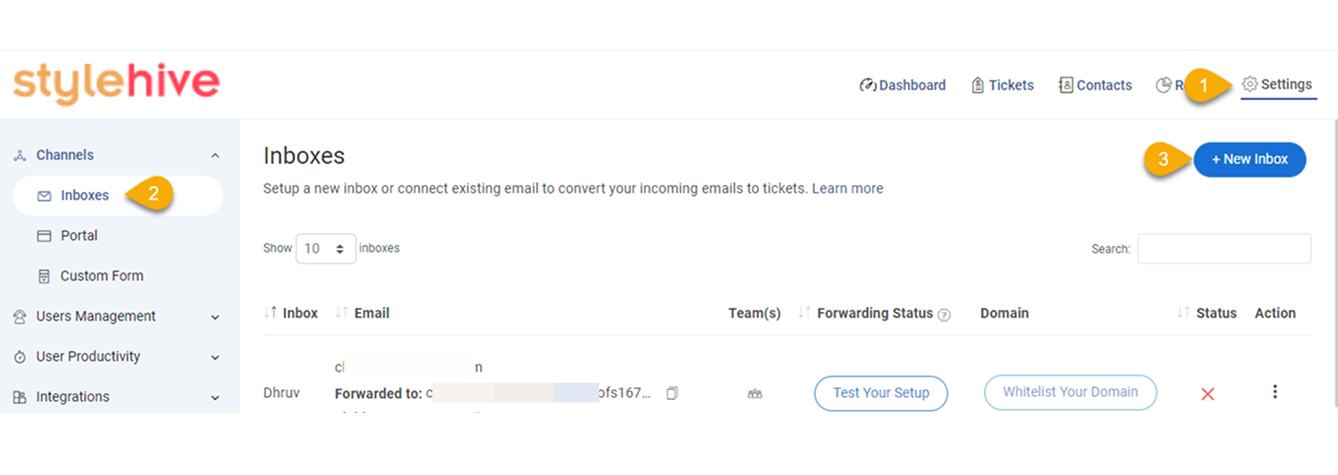
Use this method if you already have a dedicated email address for customers. It simplifies your process and gets every ticket in the inbox.
Step 2: In the next screen that appears, you can enter the following details:
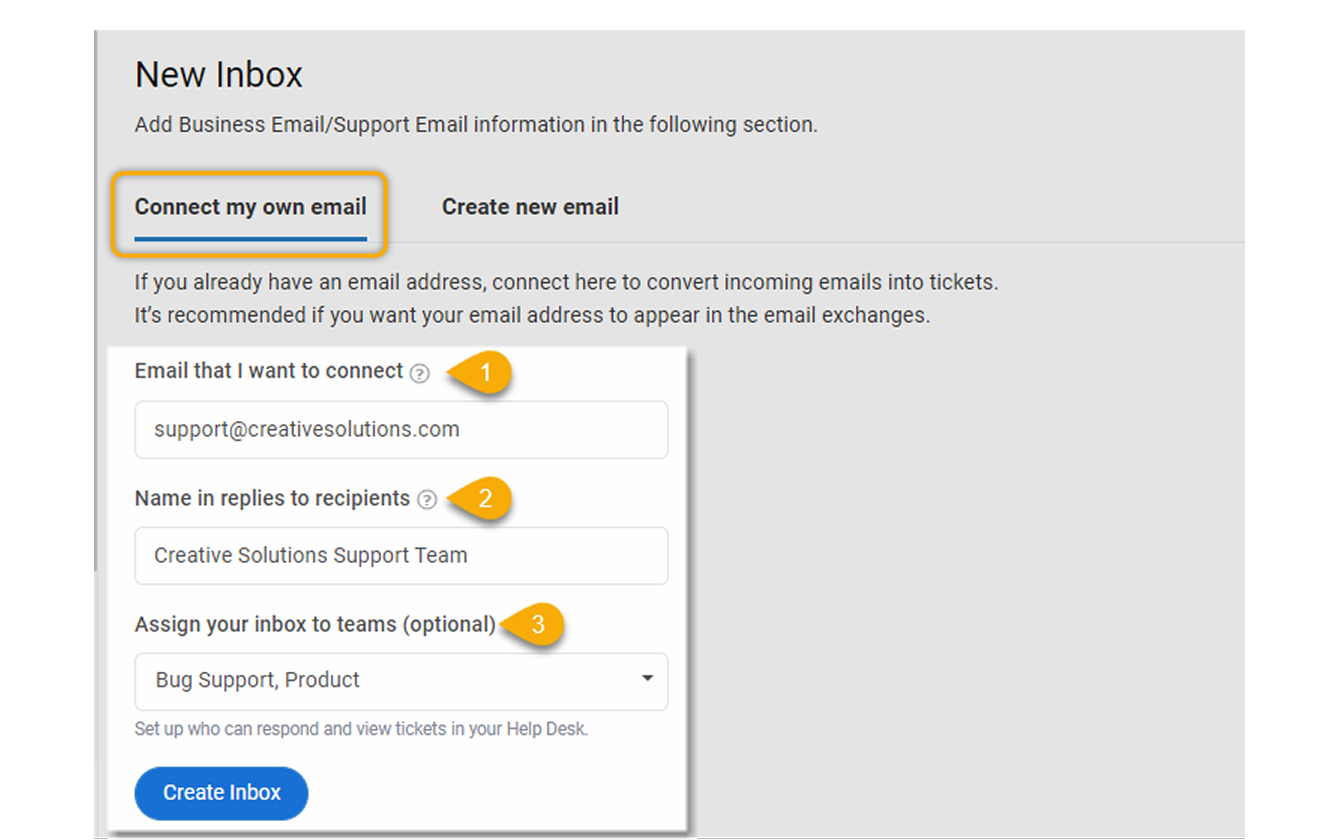
- Email that I want to connect: Enter your existing customer-facing email address (support@, sales@, etc.) from which you want to import emails as tickets.
- Name in replies to recipients: Add a respondent’s name to associate with replies to customer emails.
- Assign your inbox to teams (optional): Select single or multiple teams to which you want to assign any incoming email as tickets.
Step 3: Once done, click “Create Inbox.” Congrats! Your brand new shared inbox is ready and live.
Go From Clutter to Clarity with the Best Shared Inbox Tool
Disorganized and cluttered have been a constant source of worry for modern teams. You are often lost in a sea of unread emails leading to lost productivity and unhappy customers.
With a shared inbox, you can finally bring a sense of calm to this chaos. Team members can avoid stepping on each others’ shoes by quickly viewing who is working on what. Moreover, with team collaboration features, your team can join hands to share the best email responses.
However, choosing the right one can be challenging with so many shared inbox tools. I’ve have put ProProfs Help Desk at the top for its ease of use, multichannel capabilities, and AI-powered automation. Before settling for any tool, we advise you to thoroughly review the features and try a free trial of shared inbox software. Happy emailing!
Shared Inbox Softwares: FAQs
How to choose the best shared inbox software for your team
To choose the best shared inbox software, consider features like email assignment, automation, collision detection, and integrations with your existing tools. Look for ease of use, reporting capabilities, and scalability to match your team's growing needs. A free trial or demo can help you evaluate the best fit for your workflow.
Distribution list vs. shared inbox software: what’s the difference?
A distribution list forwards emails to multiple recipients, while a shared inbox software offers advanced collaboration features, automation, and tracking to improve team efficiency. Learn more in our blog: Distribution List vs. Shared Mailbox.
What are the other use cases of shared inbox tools besides customer success?
Besides customer success, shared inbox tools are used for sales inquiries, IT support, HR recruitment, finance queries, and general business communication. They help teams manage emails efficiently, automate workflows, and track accountability across departments.
FREE. All Features. FOREVER!
Try our Forever FREE account with all premium features!

 We'd love your feedback!
We'd love your feedback! Thanks for your feedback!
Thanks for your feedback!





